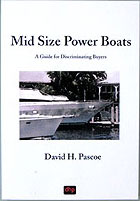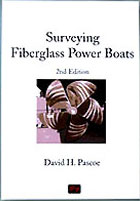Chapter 13
Steering, Controls, Systems & Equipment
Table of Contents
Ergonomics at the Helm
Engine Control Systems
Steering Systems
Helm Panel Layouts
Tops & Covers
Cockpit Appliances
Navigation Instruments
Radars
GPS/Plotters
Depth Meters
Autopilots
Other Systems
Air Conditioning
Water Makers
Water Fixtures
Navigation Lights
Ground Tackle
Anchor Windlasses
Bow Thrusters
Hydraulic Transom Platforms
Safety Gear
Excerpt
The control interface between vessel and operator, called the helm station, is one of the most overlooked design features on boats.
On sport fishermen we typically find the most thoughtfully and ergonomically designed helm stations of all, no doubt because avid fishermen are usually more experienced and demanding.
Some of the poorest designs are to be found on stylish express cruisers and others wherein style takes precedence over practicality.
The importance of this point cannot be over stressed since the owner will spend more of his time at the helm than with any other boating activity, so if he gets stuck with a bad design, he's not going to be very happy about that.
Ergonomics at the Helm
Good ergonomic design includes the ability of the pilot to stand or sit at the helm station and control the boat comfortably for relatively long periods of time.
Much will depend on the physical size of the individual, for most designers will, or at least should be, thinking about how the set up fits the average sized person. Therefore, unusually tall or short people are likely to have problems with this.
Check the set up simply by standing behind the helm. Place your hands on the wheel at what would be the normal position.
There should be adequate clearance between the seat and the wheel. Whether the wheel is vertically or horizontally mounted, you arms should be able to rest comfortably on the wheel with hands in the normal position. If the wheel is too high, or low, this will cause discomfort over longer periods of time.
Note that on many flying bridges, the helm is placed very low where it is comfortable for the sitting position but not the standing position.
This is backwards: the wheel height should first be set for a comfortable standing position and the helm chair adjustable to that height because the reverse of this is not possible.
Getting adequate clearance between the seat and the wheel is always a problem, with no good solution other than with a seat that slides fore and aft, so check to see that it does.
Adequate clearance is important during docking operations, for example, when it may become necessary to get in and out from behind the wheel quickly. We don't want a fit so tight that we get hemmed in.
Wheels are routinely found mounted anywhere from vertical to horizontal and all angles in between. A horizontal mount means anywhere from horizontal to about 15 degrees.
The sport fisherman will do more maneuvering than any other type of boat owner, so it is important to note that the wheels of nearly all fishermen are to be found in the horizontal position by reason of the fact that the wheel can be turned easier and faster from this position.
Conversely, vertically mounted wheels tend to be better for straight-line steering - as in a sea way ? when constant course adjustments are needed. Hence, we always find vertical wheels on ships and larger motor yachts.
- A Guide to Discriminating Buyers
by David H. Pascoe
Soft Cover
512 pages
Publisher: D. H. Pascoe & Co., Inc.
Published: 2003
Language: English
ISBN-10: 0965649636
ISBN-13: 9780965649636
In Stock
David Pascoe - Biography
David Pascoe is a second generation marine surveyor in his family who began his surveying career at age 16 as an apprentice in 1965 as the era of wooden boats was drawing to a close.
Certified by the National Association of Marine Surveyors in 1972, he has conducted over 5,000 pre purchase surveys in addition to having conducted hundreds of boating accident investigations, including fires, sinkings, hull failures and machinery failure analysis.
Over forty years of knowledge and experience are brought to bear in following books. David Pascoe is the author of:
- "Mid Size Power Boats" (2003)
- "Buyers’ Guide to Outboard Boats" (2002)
- "Surveying Fiberglass Power Boats" (2001, 2nd Edition - 2005)
- "Marine Investigations" (2004).
In addition to readers in the United States, boaters and boat industry professionals worldwide from over 70 countries have purchased David Pascoe's books, since introduction of his first book in 2001.
In 2012, David Pascoe has retired from marine surveying business at age 65.
On November 23rd, 2018, David Pascoe has passed away at age 71.







Normally orders ship the same day, if placed before 12:00 PM Eastern time.